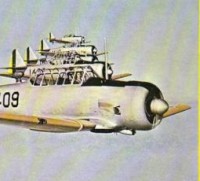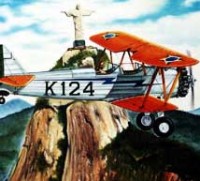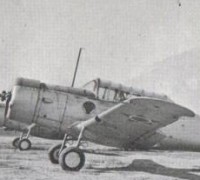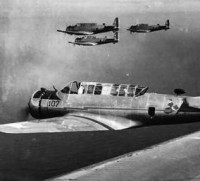BRAZILIAN AIR FORCE FAB * - BRAZILIAN AIR FORCE
27)SAVOIA MARCHETTI SM 79T
Total received: 03.
Characteristics:
Introduced 1939
Propulsion. 3 Alpha Romeo 126 RC 34 radial engines with 750Hp each.
Span: 20,2 m.
Length: 16,2 m.
Height: 4,1 m.
Wing area: 61,7m².
Empty weight: 7,700 kg.
Maximum weight: 10,050 kg.
Maximum speed: 435 km/h.
Rate of Climb: 5,3 m/sec.
Ceiling: 7,500 m. max
Range: 1900 km.
Crew. Six
Produced 1240
3 aircrafts were used in Brazilian FAB. Employed in Maritime reconaissance, training and transport
.png)
In the detail above one SM 79T under maintenance at Afonsos Airfield Rio de Janeiro, (left). One SM79T parked at Afonsos Airfield with a Focke Wulf Weihe on take off. Photo Archives from Museu Aeroespacial Brasil / Jose de Alvarenga
In the mid-1930s, the Brazilian Navy's Naval Aviation and the Brazilian Army's Military Aviation focused efforts on the modernization of their air assets and operating doctrines, as both had few and already obsolete aircraft in their collection. This demand would generate great commercial opportunities for suppliers of aircraft and military equipment, in this same period, the fascist government of the Italian dictator Benito Mussolini, was deeply engaged in a propaganda campaign of its state machine, mainly to publicize the technological superiority. of its industry, with the objective of increasing its international sphere of influence and, consequently, conquering new markets for its industrial products.
At this stage, one of the exponents of Italian technological pride was represented by the SM-79 "Sparviero", an aircraft that was often used in air races and raids and long distances in order to demonstrate the superiority of that country in the aeronautical environment. One of these initiatives contemplated a crossing of the South Atlantic, covering the same route that in the future would be operated commercially by transport planes from the company LATI (Linee Aeree Transcontinentali Italiane). In this way, three aircraft of the S-79CS Corsa (Racing) version, which were customized for this task, receiving important changes and improvements in the process, such as a modified fuselage to reduce aerodynamic drag, removal of armament-armor and inclusion of larger fuel tanks. to increase autonomy (with this last change specifically generating the version called SM-79T -Transatlantic). In addition to these, the cells would also receive an eye-catching red painting, earning the license plates "I-BISE", "I-MONI", and "I-BRUN", the latter having as pilot Bruno Mussolini, son of the Italian dictator.
The squadron named "Sorci Verdi" (Green Rats), took off from Guidonia city on January 24, 1938, to start the Rome-Dakar-Rio flight, the planes cover the first leg of the 4,500 km trip, landing in Dakar after a flight and 10:47 hours. The following day they took off for the city of Natal, however the SM-79T "I-MONI" had problems in one of the propellers which resulted in a loss of speed, causing the aircraft to remain in this city, the two others followed in trip to the city of Rio de Janeiro, where they arrived at 10:45 pm, completing a route and 9,850 km, at an average speed of 404 km/h. After the repairs were completed on the SM-79T "I-MONI", it arrived in the city of Rio de Janeiro the next day.
This daring raid made it possible to prove that the establishment of a commercial route for the transport of cargo and possibly passengers between Italy and Brazil was technically feasible and fully safe, opening the door for LATI (Linee Aeree Transcontinentali Italiane) to operate the civil version of the aircraft on a regular basis. . This event reached its peak on February 22, 1938, when Lieutenant Bruno Mussolini officially donated the SM-79T "I-BRUN" aircraft in a propaganda gesture to the Army Aviation (AvEx), generating interest on the part of the Brazilian Federal Government, in a gesture of reciprocity, negotiate the acquisition of the other two cells, with this process being carried out on April 27, 1938, when the three aircraft were officially incorporated into the Military Aviation of the Brazilian Army.
The three cells of the Italian model, Savoia Marchetti SM-79T were distributed to the Army Military Aviation School (EAvM) in May of the same year, with Italian officer Captain Nino Moscatelli staying in Brazil as part of the purchase agreement, where for two In the following months, he taught a course for the aviators of the Military Aviation of the Army, at the same time, it is assumed that the six mechanics and technicians original members of the "Sorci Verdi" squadron also remained in the country, being responsible for the basic training of the maintenance team of the Italian aircrafts now in service in Military Aviation. After the completion of these processes, familiarization flights with the aircraft were started.
Nominally acquired to perform long-distance aerial reconnaissance tasks, it is also speculated that the acquisition and operation of these three aircraft aimed to pave the way for the ordering of more cells in the military version, given that at this time the Savoia Marchetti model represented the state of the art in terms of technology and performance, which could have generated an important wave of modernization in Brazilian military aviation. Unfortunately, the beginning of hostilities in Europe in September 1939 and the unconditional alignment of Mussolini's government with German expansionist objectives, determined that Savoia Marchetti and the other defense industries focused primarily on the supply of aircraft to the Regia Aeronautica, which would abort any possible export negotiation in transit.
.png)
Above one SM79T parked at Afonsos Airfield, Rio de Janeiro. Photo Archive Jose Alvarenga
Despite this scenario that restricted the model's fleet to only three aircraft (which received the registrations K-420, K-421 and K-422), the Brazilian Savoia Marchetti SM-79T remained very active between 1939 and 1941. Also recording the speed record between the cities of Rio de Janeiro and Porto Alegre, being performed in 2 hours and 50 minutes at an average speed of 423 km/h. This event, recorded on July 9, 1939, would represent the high point of the career of these aircraft in Brazil. In the day-to-day tasks pertinent to the routine of the Army Military Aviation School (EAvM), the SM-79T began to be used in multi-engine training missions, with this at the time being considered the most advanced model of the Brazilian fleet. It is worth noting that the records of the time point to the inclusion in the contract of purchase of the aircraft of a batch of Breda machine guns of 12.7 mm caliber, but there is no documentary or photographic proof that this weapon was installed in the Brazilians Savoia Marchetti SM-79T.
In January 1941, the movement to create the Ministry of Aeronautics and the Brazilian Air Force (FAB) would determine the transfer of all Naval Aviation and Military Aviation aircraft to this new air weapon, among these were the three Savoia Marchetti SM-79T, that were quickly allocated to the Aeronautics School (EAer) for use in multi-engine training and navigation missions. Even with the lack of an adequate flow of spare parts (due to the commercial blockades due to the war in Europe), the maintenance team of the Aeronautics School (EAer) was successful in maintaining the availability of the three aircraft.
In the middle of the same year, studies were carried out aiming at the possible conversion of aircraft for use in transport tasks, with these works being originally planned to be carried out in the workshops of the Parque de Aeronáutica dos Afonsos. However, increasingly frequent problems in the importation of spare parts, allied to the factor of the small cargo transport capacity of the aircraft, would lead to the cancellation of this program. The receipt of new training aircraft of North American origin from the end of 1942, would accelerate the deactivation process of the Savoia Marchetti SM-79T, in February 1943 a cell would be unloaded, with the last flight recorded taking place on 29. In June of the same year, the last two aircraft were deactivated and sold in October 1944, ending the career of Italian three engines in Brazil.
Article translated from Armas Nacionais - Modelismo & História: Savoia Marchetti SM-79T no Brasil



